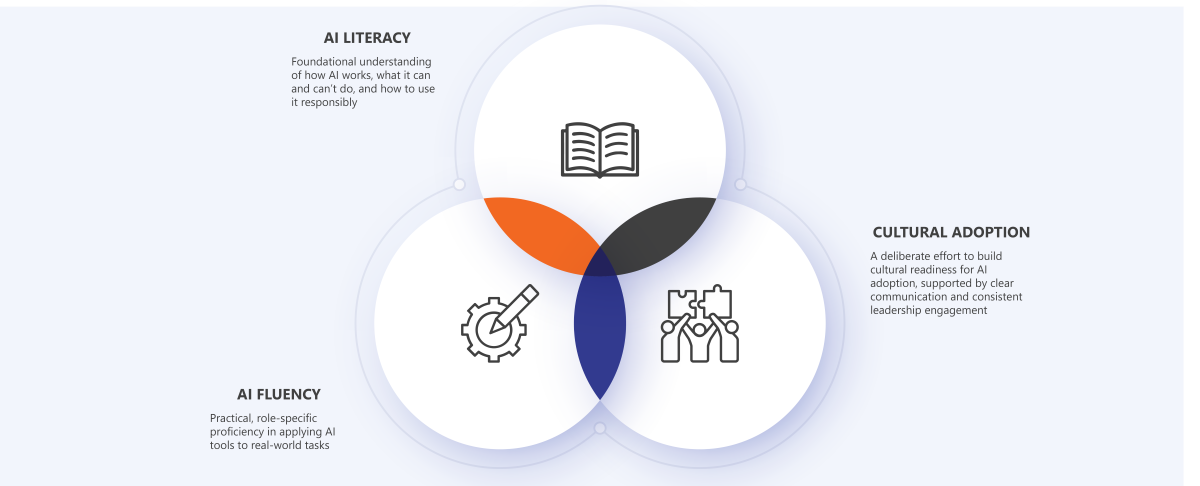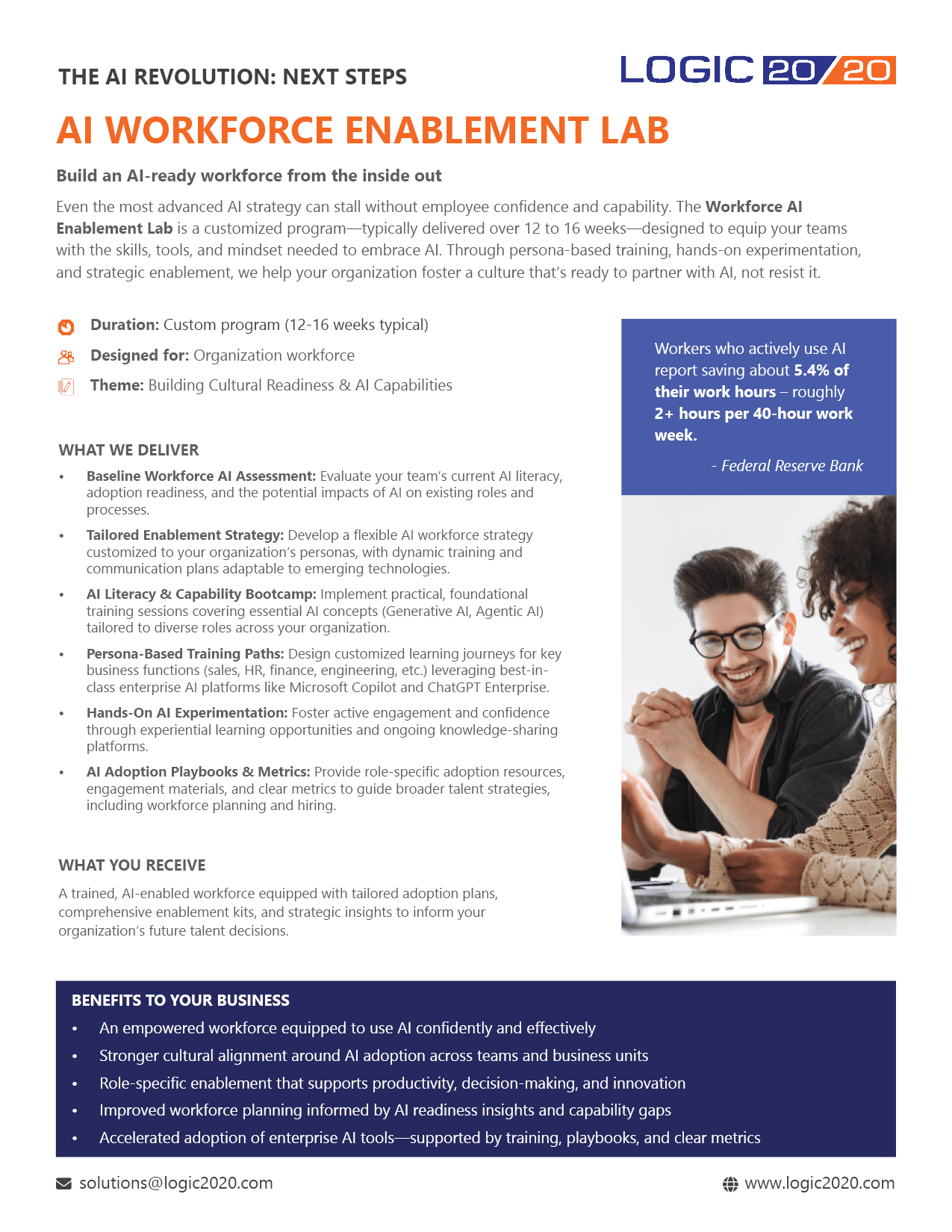6-minute read
Quick summary: How AI workforce enablement bridges the gap between technology and adoption, empowering teams to use AI confidently, responsibly, and at scale
Enterprises are investing billions in artificial intelligence (AI), anticipating gains in efficiency, innovation, and competitive edge. Yet many struggle to scale beyond pilots—and the culprit often isn’t the technology.
In many cases, the real barrier has to do with people. Without a workforce that is ready and willing to work with AI, even the most advanced tools underperform. Employees may hesitate to adopt unfamiliar systems, misuse them, or avoid them entirely.
That’s where AI workforce enablement comes in. By equipping employees with the skills, understanding, and mindset to use AI effectively, organizations can close the gap between potential and performance.
In this article, we explore why workforce enablement is critical to AI success, what it looks like in practice, and how to build a strategy that aligns people and technology from day one.
Article continues below.
WEBINAR
Logic20/20’s COO explores where AI stands today, what matters most for enterprise adoption, and how to avoid costly missteps.
We will never sell your data. View our privacy policy here.
Why technology alone isn’t enough
Lack of training, unclear communication, and cultural friction frequently prevent AI initiatives from progressing beyond the pilot phase. Left unaddressed, these hurdles result in low adoption, misuse, and the rise of “shadow tools”—unauthorized AI applications used outside of IT oversight, often with inconsistent results.
To realize the full value of AI, companies need to invest in their workforce as intentionally as they invest in technology. Preparing people to engage with AI confidently and constructively is not simply a nice thing to do—it’s essential to turning potential into performance.
What is AI workforce enablement?
AI workforce enablement is a strategic initiative to equip employees with the mindset, knowledge, and tools to use AI effectively over the short, medium, and long term. An effective AI workforce enablement strategy incorporates three core components:
- AI literacy: Foundational understanding of how AI works, what it can and can’t do, and how to use it responsibly
- AI fluency: Practical, role-specific proficiency in applying AI tools to real-world tasks
- Cultural adoption: A deliberate effort to build cultural readiness for AI adoption, supported by clear communication and consistent leadership engagement
These components apply across the organization. Technical teams may need to upskill in new AI frameworks. Business units may need to reskill in applying AI outputs to decision-making. In both cases, the goal is the same: build confidence, reduce friction, and create a culture where AI is a normal part of how work gets done.
To help our clients coordinate and implement these components, Logic20/20 developed the AI Workforce Enablement Lab—a structured program that combines readiness assessments, strategy, staff engagement, training, and adoption measurement into one cohesive framework.

Benefits AI workforce enablement
For enterprises aiming to scale AI and realize measurable value, workforce enablement delivers an array of key advantages:
1. Driving adoption and ROI
AI investments pay off only when employees use the solutions. Prioritizing workforce enablement helps ensure employees embrace their new tools in day-to-day work, which accelerates returns on AI projects.
2. Boosting productivity and innovation
When employees understand AI’s capabilities, they become partners in innovation rather than passive end-users, which often leads to new process optimizations and use cases coming from the front lines.
3. Reducing resistance
AI workforce enablement programs show employees the “why” and “how” of AI, transforming skepticism into enthusiasm. By building change management practices into their strategies, organizations avoid the common pitfall of poorly planned tech rollouts that meet with pushback or confusion.
4. Promoting responsible use
Trained employees are more likely to use AI responsibly according to established governance policies. For example, if staff are educated on AI limitations (like understanding that a generative AI might produce plausible-sounding but incorrect answers), they can provide the necessary human oversight, which mitigates risks of misuse and helps maintain compliance and quality standards.
These outcomes don’t happen by default. They result from deliberate investment in people—an approach that Logic20/20 builds into every AI engagement, starting with readiness assessments and continuing through targeted training and change management support.
Strategies for workforce-centered AI adoption
Ensuring that people are ready to use AI solutions—and use them well—requires a coordinated, people-first approach. The following strategies help organizations build the confidence, clarity, and capability needed for successful adoption:
- Start with a workforce readiness assessment: Assessing preparedness before rollout surfaces gaps in skills, understanding, and mindset, allowing organizations to tailor support where it’s needed most.
- Tailor training to roles and functions: Different teams—such as sales, HR, and engineering—require different learning paths based on how AI fits into their workflows.
- Establish staff engagement channels: Office hours, a champions network, and other channels provide staff with continuous opportunities to voice concerns and get questions answered.
- Encourage hands-on experimentation: Giving teams opportunities to explore AI tools in low-risk settings helps build confidence and fluency.
- Support adoption with clear playbooks and defined metrics: These tools help teams stay aligned and reinforce long-term behavioral change.
- Establish feedback loops: Gathering regular input from users enables continuous improvement in training and adoption strategies.
- Address concerns directly: Many employees worry that AI will replace them. Effective enablement reframes AI as a collaborator, augmenting human skills rather than replacing them.
Real-world results: Stories from the field
Two recent examples show how aligning people and technology can turn promising AI tools into impactful solutions.
Copilot adoption for a global sales organization
A global technology company launched Microsoft Copilot to a 60,000-person sales force with a clear goal: enhance productivity and position the business for AI-driven growth. Yet success required more than a platform—it called for a strategic enablement effort that could reach teams across 200+ countries.
Logic20/20 partnered with the organization to design and implement a scalable adoption framework tailored to the sales team’s complexity. This included role-specific training assets, a hub-and-spoke communication model, and dynamic adoption data modeling to track engagement and sentiment in real time. Feedback loops and gamified learning resources ensured the approach remained responsive to users’ needs.
The result: accelerated adoption of Copilot, increased awareness and alignment among global teams, and a repeatable strategy the organization can extend to future AI initiatives. The sales workforce gained the clarity, support, and confidence needed to integrate AI into their daily workflows.
AI assistant for a utility’s emergency operations
In a high-pressure emergency response setting, trust and clarity are non-negotiable. Logic20/20 supported a large regional utility in implementing an AI assistant to aid real-time decision-making during critical events. The initiative’s success hinged not only on the technology itself, but on preparing teams to use it effectively.
A dedicated change management effort ensured this readiness by incorporating role-specific training, early user feedback, and internal champions to promote adoption. The enablement effort helped shift responders from reactive habits to a more proactive mindset while reinforcing the assistant’s value in daily operations.
The results: an AI solution that improved situational awareness and reporting accuracy—and a workforce equipped and empowered to use it with confidence.
People-first AI delivers lasting value
AI solutions may transform industries, but their impact depends on people. A workforce that’s confident and capable in using AI is the key to translating potential into performance.
Embedding workforce enablement into an AI strategy helps organizations move faster, innovate more effectively, and sustain progress. With the right support, teams can adopt new tools, adapt to evolving roles, and create long-term value from their AI investments.
Get started on your AI Workforce Enablement Lab today.
Even the most advanced AI strategy can stall without employee confidence and capability. The Workforce AI Enablement Lab is a customized program—typically delivered over 12 to 16 weeks—designed to equip your teams with the skills, tools, and mindset needed to embrace AI. Through persona-based training, hands-on experimentation, and strategic enablement, we help your organization foster a culture that’s ready to partner with AI, not resist it.

Claire Raskob is a Manager in Logic20/20’s Digital Strategy & Transformation practice. Claire specializes in driving the successful development and adoption of new processes and technologies, with a strong focus on the human side of change. She has experience implementing large-scale projects that promote efficiency and lower compliance risk in complex regulatory environments.


